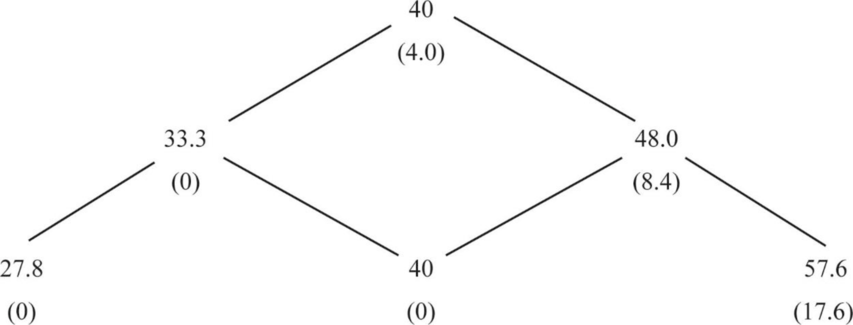
a)
To determine: Value of one month call option with $40 as an exercise price.
a)
Explanation of Solution
Given information:
Company H stock prices changes once in a month either by increase in 20% or decreases by 16.7%.
Current price level is $40 and interest rate is 1% per month.
Calculation of value of option:
First, it is necessary to find out the probabilities by using risk-neutral method.
Therefore, the value of p is 48% and,
Therefore, there is 48% of chances that price of stock will rise by 20% and a 52% chances that option will worth of $0 when it matures.
Therefore, the value of call is $3.82
b)
To determine: Value of delta.
b)
Explanation of Solution
Calculation of value of delta:
Hence, the value of option delta is 0.545
c)
To determine: The way payoffs of this call option be replicated based on replicated portfolio method.
c)
Explanation of Solution
Calculation of value of call by using replicating portfolio method:

Hence, the value of call is $3.82
d)
To determine: Value of two month call option with $40 as an exercise price.
d)
Explanation of Solution
Calculation of value of option:
The following option possibilities are as follows,

Month 1-a:
Hence the value of call under month 1-a is ‘0’
Month 1-b:
Therefore, value of the call under month 1-b is $8.4
Month 0:
Therefore, value of the call under month 0 is $4.0
e)
To determine: Value of delta.
e)
Explanation of Solution
Calculation of delta:
Hence, the delta value is 0.572
Want to see more full solutions like this?
Chapter 21 Solutions
Principles of Corporate Finance (Mcgraw-hill/Irwin Series in Finance, Insurance, and Real Estate)
- An accounts payable period decrease would increase the length of a firm's cash cycle. Consider each in isolation. Question 6 options: True Falsearrow_forwardWhich of the following is the best definition of cash budget? Question 10 options: Costs that rise with increases in the level of investment in current assets. A forecast of cash receipts and disbursements for the next planning period. A secured short-term loan that involves either the assignment or factoring of the receivable. The time between sale of inventory and collection of the receivable. The time between receipt of inventory and payment for it.arrow_forwardShort-term financial decisions are typically defined to include cash inflows and outflows that occur within __ year(s) or less. Question 9 options: Four Two Three Five Onearrow_forward
- A national firm has sales of $575,000 and cost of goods sold of $368,000. At the beginning of the year, the inventory was $42,000. At the end of the year, the inventory balance was $45,000. What is the inventory turnover rate? Question 8 options: 8.46 times 13.22 times 43.14 times 12.78 times 28.56 timesarrow_forwardThe formula (Cash cycle + accounts payable period) correctly defines the operating cycle. Question 7 options: False Truearrow_forwardAn accounts payable period decrease would increase the length of a firm's cash cycle. Consider each in isolation. Question 6 options: True Falsearrow_forward
- Which of the following issues is/are NOT considered a part of short-term finance? Question 5 options: The amount of credit that should be extended to customers The firm determining whether to issue commercial paper or obtain a bank loan The amount of the firms current income that should be paid out as dividends The amount the firm should borrow short-term A reasonable level of cash for the firm to maintainarrow_forwardLiberal credit terms for customers is associated with a restrictive short-term financial policy. Question 3 options: True Falsearrow_forwardAn increase in fixed assets is a source of cash. Question 2 options: True Falsearrow_forward
- If the initial current ratio for a firm is greater than one, then using cash to purchase marketable securities will decrease net working capital. True or falsearrow_forwardwhat is going to be the value of American put option that expires in one year modeled with a binomial tree of 3 months step with year to expiry? assume the underlying is oil future with RF of 5% and vol of oil is 30%. Strike is 70 and price is 60 of oil. 13.68 13.44 13.01arrow_forwardhello tutor need step by step approach.arrow_forward
 Intermediate Financial Management (MindTap Course...FinanceISBN:9781337395083Author:Eugene F. Brigham, Phillip R. DavesPublisher:Cengage Learning
Intermediate Financial Management (MindTap Course...FinanceISBN:9781337395083Author:Eugene F. Brigham, Phillip R. DavesPublisher:Cengage Learning
